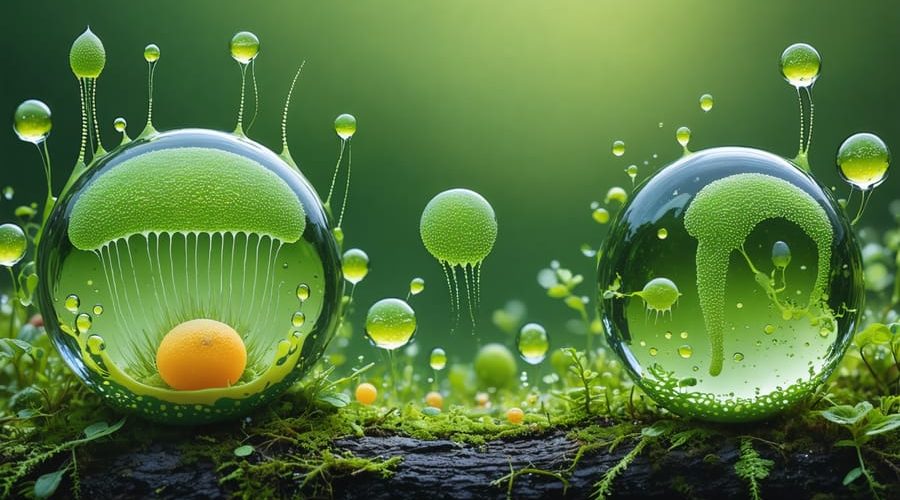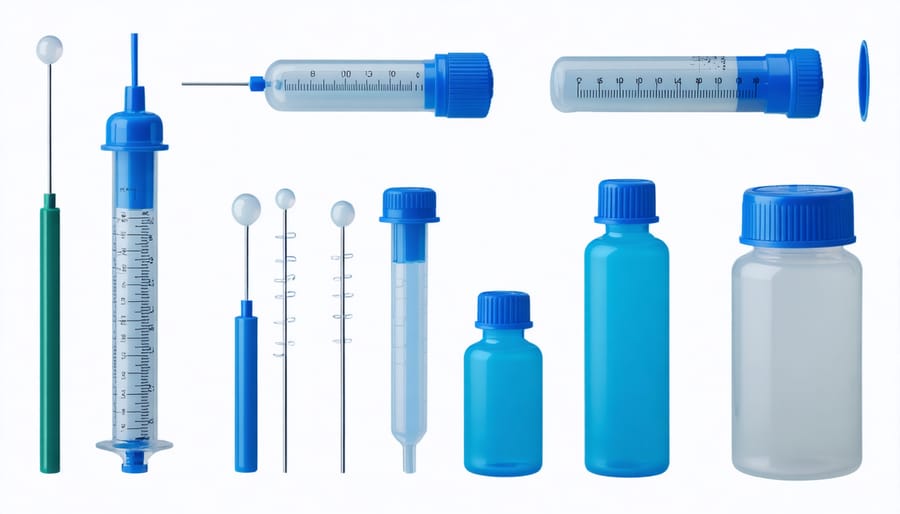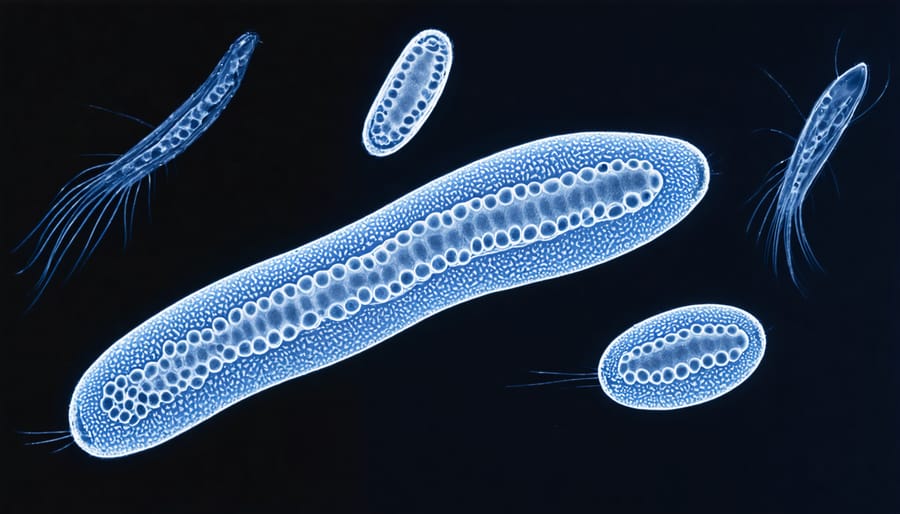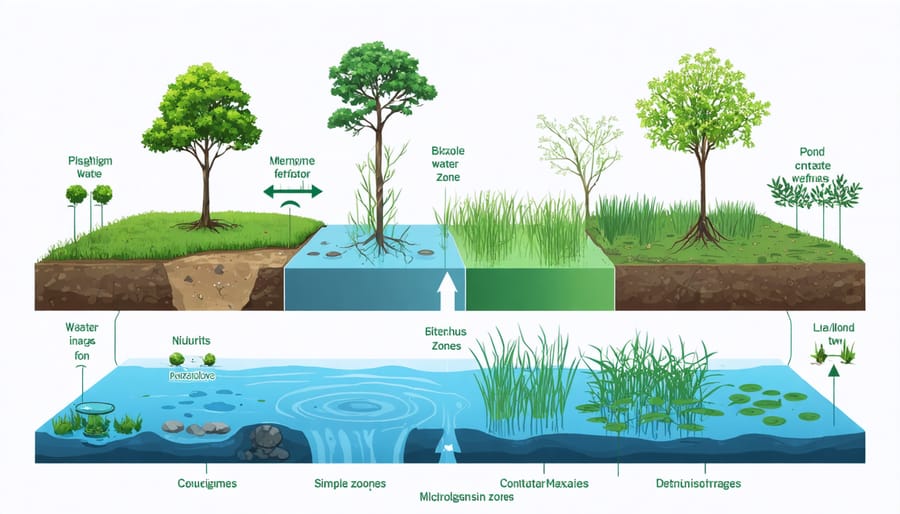
Pond Water Secrets: What Your Microscope Reveals About Microhabitat Health
Peer through your microscope into a fascinating miniature world where countless microorganisms create thriving ecosystems right in your backyard pond. From graceful paramecia gliding through water droplets to colonies of vorticella dancing on invisible stems, pond water teems with life visible only at 400x magnification. Understanding these microscopic inhabitants reveals crucial information about your pond’s health, water quality, and biological balance. Whether you’re a curious hobbyist or dedicated pond keeper, learning to identify these tiny organisms opens up a new dimension of pond maintenance and appreciation. With basic equipment and proper techniques, you’ll discover how these invisible players support your pond’s larger ecosystem, influence water clarity, and contribute to overall pond health. This guide walks you through the essential steps of collecting, preparing, and identifying common microorganisms, helping you become a better steward of your aquatic environment.
Essential Equipment for Microorganism Identification
Basic Collection Tools
To get started with identifying microorganisms in your pond water, you’ll need some basic collection tools that are easily accessible. A clean glass jar or clear plastic container with a tight-fitting lid is essential for collecting and storing your water samples. Make sure these containers are thoroughly cleaned and rinsed to avoid any contamination.
You’ll also need an eyedropper or plastic pipette for precise sample collection and transfer. These tools allow you to gather water from different depths and areas of your pond. Consider having multiple droppers if you plan to take samples from different locations.
A long-handled dipper or sampling pole can be helpful for reaching deeper areas or spots far from the pond’s edge. You might also want to collect some pond vegetation in separate containers, as microorganisms often attach themselves to plant matter.
For temporary storage, clean plastic bags can be useful when collecting plant samples. Don’t forget to label your containers with the date and location of collection. Having a small notebook and waterproof markers handy will help you keep track of your samples.
Remember to handle all equipment carefully and avoid cross-contamination between different sampling areas.

Microscope Setup for Pond Water
Getting a clear view of pond microorganisms doesn’t require expensive equipment! A basic compound microscope with 40x to 400x magnification works perfectly for most observations. Start by placing a drop of pond water on a clean glass slide and gently lower a coverslip over it to prevent the sample from drying out.
For the best viewing experience, adjust your microscope’s lighting using the diaphragm beneath the stage. Begin with the lowest magnification objective lens (usually 4x or 10x) to locate interesting specimens, then gradually increase magnification to see more detail. If your sample appears too crowded, dilute it with a drop of filtered water.
Pro tip: Keep your slides and coverslips spotlessly clean – even tiny smudges can interfere with viewing. Also, try collecting samples from different pond areas, as microorganisms tend to gather in specific zones. Near plants, along the bottom, or at the water’s surface often yield the most interesting finds.
Remember to focus carefully and move the slide slowly – these tiny creatures can zip across your field of view in a flash! For clearer images, you might want to add a drop of methyl cellulose to slow down fast-moving organisms.
Common Microorganisms in Healthy Pond Water
Beneficial Protozoans
While some microorganisms can be harmful, many protozoans in your pond water actually serve as beneficial microorganisms that help maintain a healthy ecosystem. Paramecium, for instance, are oval-shaped single-celled organisms that swim using tiny hair-like structures called cilia. These fascinating creatures act as natural filters, feeding on bacteria and helping to keep your pond water clean.
Another helpful protozoan you might spot is the Vorticella, which looks like a tiny bell attached to a long stalk. These organisms attach themselves to plants or debris and create water currents to trap food particles, contributing to water clarity. You’ll often see them in groups, creating a beautiful microscopic garden in your pond.
Amoebas are also common residents in healthy pond water. These shape-shifting protozoans move by extending parts of their body called pseudopods, and they help break down organic matter at the bottom of your pond. Think of them as tiny cleanup crews working 24/7 to maintain your pond’s balance.
One of the most elegant protozoans you might encounter is the Stentor, trumpet-shaped organisms that can attach to surfaces or swim freely. They’re excellent indicators of good water quality and help control bacterial populations. When you see these creatures under your microscope, it’s usually a sign that your pond is thriving.
Remember, a diverse population of protozoans indicates a balanced ecosystem, so their presence should be celebrated rather than feared. They’re nature’s own maintenance team, keeping your pond naturally clean and healthy.

Helpful Algae and Bacteria
Not all microscopic life in your pond is harmful – in fact, many types of algae and bacteria play crucial roles in maintaining a healthy aquatic ecosystem. Beneficial algae, like Chlorella and Spirulina, produce oxygen through photosynthesis and serve as natural food sources for fish and other pond inhabitants. These algae help maintain water clarity and compete with harmful algae for nutrients, naturally preventing algal blooms.
Beneficial bacteria are the unsung heroes of pond health. Nitrifying bacteria, such as Nitrosomonas and Nitrobacter, are essential for breaking down fish waste and decaying organic matter. They convert harmful ammonia into less toxic nitrites and eventually into nitrates, which plants can use as fertilizer. This process, known as the nitrogen cycle, is fundamental to maintaining clean, clear water.
You can spot beneficial algae under the microscope as bright green, uniformly shaped cells, often in colonies or chains. While beneficial bacteria are typically too small to see clearly without special equipment, their presence is indicated by healthy water parameters and thriving pond life.
Some other helpful microorganisms include:
– Diatoms: Beautiful glass-like algae that help oxygenate water
– Purple sulfur bacteria: Natural water purifiers that break down hydrogen sulfide
– Photosynthetic bacteria: Additional oxygen producers that support aquatic life
Remember, a balanced ecosystem needs these beneficial microorganisms. While it’s tempting to try to eliminate all algae and bacteria, focus instead on maintaining healthy populations that support your pond’s natural biological filtration.

Microhabitat Zones and Their Unique Organisms
Surface Water Communities
Surface water communities are fascinating miniature ecosystems teeming with diverse microorganisms. In these different pond zones, you’ll discover an amazing variety of tiny life forms, each playing a unique role in maintaining the water’s health.
Common inhabitants include algae, which range from single-celled forms to colonial species that create green patches in the water. You’ll often spot protozoa like paramecium and amoeba, which glide through the water hunting for bacteria and organic matter. These single-celled organisms are nature’s cleanup crew, helping to maintain water clarity.
Rotifers, also known as “wheel animals,” are slightly larger and use their crown of cilia to create water currents that draw in food particles. Water fleas (Daphnia) and copepods dart through the water, feeding on algae and smaller organisms. These crustaceans are excellent indicators of pond health.
You might also encounter water bears (tardigrades), microscopic worms called nematodes, and various bacteria species. Each organism contributes to the pond’s ecological balance, forming a complex food web that supports larger aquatic life. The presence and abundance of specific microorganisms can tell you a lot about your pond’s overall health and water quality.
Bottom Layer Ecosystems
The bottom layer of your pond is a fascinating microhabitat teeming with unique organisms adapted to life in the sediment. These bottom-dwellers play crucial roles in breaking down organic matter and maintaining your pond’s health.
Common microorganisms you’ll find here include various species of flatworms, which glide along the substrate hunting for food, and tube-dwelling rotifers that create temporary homes in the mud. Nematodes, or roundworms, are abundant in this layer and help decompose organic material.
One of the most interesting bottom-layer residents is the tardigrade, also known as the water bear. These microscopic creatures are incredibly resilient and can be spotted slowly moving through the sediment. You might also observe bell-shaped vorticella attached to debris, using their cilia to create feeding currents.
To observe these bottom-dwelling organisms, carefully collect a small sample of sediment using a turkey baster or long-handled spoon. Mix a tiny amount with pond water on your slide, and let it settle for a few minutes before viewing. The most active organisms will emerge from the sediment, making them easier to spot.
Keep in mind that a healthy bottom layer should host diverse microorganisms. Too many of certain species, like nematodes, might indicate excess organic matter, while too few organisms could suggest poor water quality.
Using Microorganisms as Health Indicators
Warning Signs to Watch For
A healthy pond typically has a balanced ecosystem, but certain signs can indicate potential problems with microscopic life. Watch for unusually cloudy or green water, which often suggests an algae bloom. While some algae is normal, excessive growth can signal an imbalance in nutrients or oxygen levels.
Pay attention to unusual odors – a strong, foul smell might indicate anaerobic bacteria overgrowth or decomposing organic matter. Fresh, healthy pond water should have little to no noticeable odor.
Keep an eye on your fish’s behavior. If they’re gasping at the surface or showing reduced activity, this could indicate poor water quality due to harmful microorganism growth. Similarly, sudden fish deaths warrant immediate investigation of microscopic life.
Surface film or foam can suggest bacterial or protozoal issues. While some surface movement is natural, thick or oily films need attention. Watch for rapid changes in water clarity or color, as these often indicate sudden microorganism population shifts.
Plant health is another indicator – yellowing leaves or dying vegetation might signal imbalances in beneficial microorganisms. Excessive slimy growth on rocks or pond walls could mean opportunistic bacteria are thriving due to poor water conditions.
Regular observation of these warning signs helps maintain a healthy pond ecosystem and prevents serious problems before they develop.
Positive Health Markers
When examining pond water under a microscope, certain microorganisms indicate a healthy pond ecosystem. The presence of diverse protozoans, like paramecium and vorticella, suggests good water quality and balanced nutrient levels. These tiny creatures help break down organic matter and keep bacterial populations in check.
Rotifers are another positive indicator – these wheel-like organisms are sensitive to pollution, so their presence means your water is clean. You might also spot water fleas (daphnia) darting around; they’re excellent natural filters and provide food for larger pond inhabitants.
Green algae in moderate amounts is actually beneficial, producing oxygen and supporting the food chain. Look for euglenoids and desmids – these photosynthetic organisms indicate stable water conditions. The key is variety – seeing multiple types of microorganisms rather than a single dominant species.
Healthy pond water should contain a mix of producers (algae), consumers (protozoans), and decomposers (bacteria). This microscopic community works together, creating a natural filtration system. If you spot water bears (tardigrades), that’s a bonus – these tough little creatures thrive in well-maintained environments.
Remember, seasonal changes affect microbial populations, so regular monitoring helps you understand your pond’s normal patterns and spot potential issues early.
Regular monitoring of your pond’s microscopic inhabitants is more than just a fascinating hobby – it’s a vital part of maintaining a healthy aquatic ecosystem. By now, you’ve learned how to collect samples, prepare slides, and identify various microorganisms under the microscope. Remember that each tiny creature plays a crucial role in your pond’s balance, from the algae that produce oxygen to the protozoans that help control bacterial populations.
Make it a habit to check your pond water samples at least monthly, keeping a simple log of what you observe. Changes in the types and numbers of microorganisms can alert you to potential problems before they become serious. For instance, a sudden boom in certain algae species might indicate excess nutrients, while a decline in diversity could suggest water quality issues.
Don’t be discouraged if identification seems challenging at first – like any skill, it gets easier with practice. Keep your reference materials handy, and consider joining online pond communities where you can share observations and learn from others’ experiences. As you become more familiar with your pond’s microscopic residents, you’ll develop a deeper appreciation for this amazing underwater world.
By staying curious and consistent in your monitoring efforts, you’ll be better equipped to maintain a thriving pond ecosystem that brings joy and beauty to your outdoor space for years to come.
